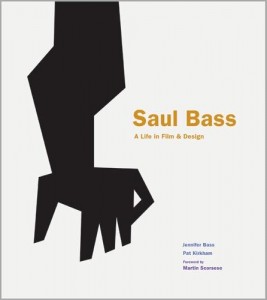Saul Bass: A Life in Film and Design by Jennifer Bass and Pat Kirkham (Lawrence King Publishers, November 2011). 424 pages. ISBN: 978-1856697521 (hardback). £48.
About the Reviewer: Dr Rob Banham is Associate Professor at the University of Reading where he teaches undergraduate design practice, lectures on the history of graphic communication, and runs the Department's professional assignments scheme. He has a particular interest in using archives and collections for teaching and learning. He edits and designs The Ephemerist (journal of the Ephemera Society (www.ephemera-society.org.uk)
The two giants of American graphic design are Paul Rand and Saul Bass. Rand is much more accessible – there are four major books about him and he also wrote several books himself. In contrast Saul Bass: A Life in Film and Design is the first book about the work of Bass and as such is long overdue. At its centre are two chapters on Bass’s movie titles and another on the films that he directed. It also includes a short biography and chapters on his early work as an advertising designer and later career in corporate identities. The latter is an area in which Bass was a pioneer and in which his contribution is often overlooked; he designed a huge number of identities including those of business giants AT&T, Minolta, United Airlines, and Warner Communications.
However, there were other pioneers in this field both in the US and in Europe and it is in designs for movie posters and titles that Bass made the greatest impact and deserves the most recognition. This, after all, is the man responsible for the opening titles for Vertigo (1958), North By Northwest (1959), Psycho (1960), Spartacus (1960), and Goodfellas (1990). The man whose opening sequence for Otto Preminger’s The Man With The Golden Arm (1955) is widely regarded to have revolutionised movie titles, famously being sent out with instructions to projectionists not to run the first reel until the curtains had been drawn back (in many cinemas the credits began while the curtains were still closed). Bass proved to be a master of the art, with an uncanny knack of setting exactly the right mood for the film that followed - he designed title sequences for over fifty films. Bass was also an outstanding director in his own right, directing scenes in other people’s films, several shorts (including in 1968 the Oscar-winning Why Man Creates), and one feature – cult film Phase IV (1974). Seeing his storyboards for the shower scene in Psycho, the final battle in Spartacus, and the (sadly never shot) epilogue to Phase IV is a genuine delight.
Bass’s contribution to film does not stop at title sequences
Bass’s contribution to film does not stop at title sequences. He was also responsible for a huge number of movie posters, many of which are now design icons. Much less well known is a great variety of other printed designs relating to films – casting call announcements, invitations to parties and premiers, mailing labels, soundtrack album covers, trade ads, newspaper ads, billboards, premier programmes. The examples shown in the book not only show another side to the work of Saul Bass but also an interesting illumination into the way that Hollywood worked in the 1950s and 1960s. It is also fascinating to see work by Bass that never saw the light of day from preliminary sketches that he rejected in favour of other ideas and finished designs that were never used.
 The book is well designed with generous amounts of white space though personally I would have happily sacrificed some of the space for less bulk and a book which was easier to handle and more comfortable to read. It is very much a celebration of his work (and that of his wife Elaine with whom he worked in close collaboration). Perhaps unsurprisingly given that it is edited and compiled by Saul and Elaine’s daughter, Jennifer Bass, and written by Pat Kirkham, a friend of the family, the book lacks a critical edge. He was undoubtedly a genius but surely there were times when he got it wrong or at least fell short of brilliance. Overall, however, the book provides a terrific overview of the man and his work. At 424 pages and with over 1400 illustrations you get a lot of book for your £48 and it is really a must buy for anyone with an interest in movie titles or the history of graphic design.
The book is well designed with generous amounts of white space though personally I would have happily sacrificed some of the space for less bulk and a book which was easier to handle and more comfortable to read. It is very much a celebration of his work (and that of his wife Elaine with whom he worked in close collaboration). Perhaps unsurprisingly given that it is edited and compiled by Saul and Elaine’s daughter, Jennifer Bass, and written by Pat Kirkham, a friend of the family, the book lacks a critical edge. He was undoubtedly a genius but surely there were times when he got it wrong or at least fell short of brilliance. Overall, however, the book provides a terrific overview of the man and his work. At 424 pages and with over 1400 illustrations you get a lot of book for your £48 and it is really a must buy for anyone with an interest in movie titles or the history of graphic design.
Dr Rob Banham